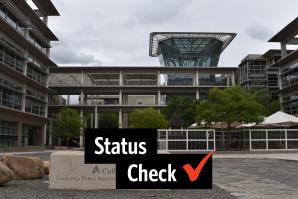Brett Sargent is the founder and CEO of True North Consulting.
(Photo courtesy of Brett Sargent)

Brett Sargent, founder and CEO of True North Consulting in El Dorado Hills, has educated himself on the PPP program — and is also trying to help inform other small-business owners. Comstock’s spoke with Sargent about the advice he shares.
With the extension being signed by President Trump,
what’s the situation now for businesses?
Businesses really have two options. Option No. 1, they continue
as they had previously. They go ahead and they use the eight
weeks up. Many people who got their PPP loans early, they can
just go ahead and do that. My recommendation to them is do that
and here is the reason why: Right now is an on-off switch. You
get to pick either eight weeks or 24 weeks, one of the two.
If you pick 24 weeks, that’s wonderful that you have that additional time and some people need it. But then you’re stuck with the payroll salary amount (restriction), which is you can’t reduce payrolls by more than 25 percent for non-highly compensated people (making less than $100,000 annually.)
You (also) have the headcount restriction. It says that if you reduced headcount between Feb. 15, 2020, and April 26, 2020, you had until June 30 to bring your headcount back up to that level to avoid any headcount reduction. Now what it’s saying is that timeframe is Dec. 30. Now it did give you an out to say, “Hey, my business has not come back to its normal levels and so I can’t hire people back.” But exactly what’s needed to document that is not very clear.
The other thing that’s happened in there for the headcount reduction, previously (the PPP program) said, “Hey, you tried to hire someone, they said, ‘No, I’m going to stay at home on unemployment getting an extra $600 a week. No, I’m not coming back to work.’” You are obligated to report them to unemployment insurance within 30 days. Now, if you choose the 24-week path, not only do you have to report them, but you have to make an effort to replace that person and you have to document that you made an effort to go back out and rehire to fill that seat.
What I’ve been telling my business owners is that if you have not spent the money, you need to have the additional time to spend the money, you’re comfortable with your forecast, you’re comfortable with the amount of business you have coming in, and that you can meet Feb. 15, 2020, headcount totals, then take the 24 weeks.
But be very careful. No one has a crystal ball. What happens if the economy starts going south in Q4 and you need to lay people off?
Do you have a preference between the eight weeks and the 24 weeks? Do you think one is better?
It all depends on the circumstance, but my instinct would say the eight-week is better. When people got their loans, it was 2.5 times 2019 monthly average salary or 12 months backward-looking. But most banks required 2019. … You’re set up on a 2.5 times amount and then you started hiring people back.
Many people are four, six weeks into the program. They’ve already brought people back. Business is happening, they’re hiring people or hired people back, people are being paid and so forth. My instinct would say go with the eight-week.
The only people that I say, ‘Hey look, you should really give the 24-week (a try)’ are people that shut their businesses down, that closed the doors, that had to lay off 80 percent of their staff because they’re a phase III recovery business. These are people like European Wax Center, (which) is one of my clients, gyms, fitness centers, nail salons, restaurants, where they got the PPP money but they have not been able to bring their people back. I’m saying definitely go after the 24 weeks.
But for most essential businesses, my recommendation is stay with the eight weeks. The money would have already been spent, you get out of the whole headcount reduction, salary reduction, which could come back to haunt you if you choose the 24-week period. Because if business is bad at the end of the year, you’re going to end up not getting your loan forgiven because you don’t have the headcount to support the same as Feb. 15, 2020.
What are the smartest things that businesses can be doing right now in regard to PPP?
No. 1, don’t do anything unnatural. Don’t run around and try to give everyone a dollar raise. Don’t run around and … give everyone a $1,000 bonus. Don’t try to get super-creative and try to pull in expenses, prorate commissions, prorate bonuses, unless you can completely justify it.
No. 2, record all of your costs. There still has not been a decision on garbage and sewer. Is garbage and sewer entitled to be a utility expense or not (under the PPP program), I don’t know. No one will give a concrete answer on that.
The other thing is, people are talking about mortgage and rent on personal property. Well, does that include my vehicles? Does that include equipment? Does that include copier machines? My instinct says no, it does not, it’s for facilities. However, no one has concrete come out and said, “It is only for facilities.” But I’ve talked to the SBA and they said that was the intent. But again, no one has been concrete on that.
Just document your expenses and if you have plenty of expenditures to fully justify your eight-week spend, stay with the eight weeks. Don’t jump on the 24-week period.
–
Stay up to date on the effects of the coronavirus on people and business in the Capital Region: Subscribe to the Comstock’s newsletter today.
Recommended For You

Waiting for Workers
Staffing agencies are ready to fill jobs as soon as companies begin rehiring
The combined region of Sacramento, Placer, El Dorado and Yolo counties lost 800 professional and business services jobs between February and March. Those job losses have affected local staffing agencies.

Status Check: Cloudy Days for Pensions?
COVID-19 might lead to even fewer defined-benefit pensions in the private sector
It’s still early to fully gauge what effects the coronavirus economic shutdown will have on the pension landscape, but the preliminary outlook for certain parts of the industry, particularly with defined-benefit plans, isn’t encouraging.

Recovery Center
Despite the faltering economy due to the coronavirus, GSEC’s Barry Broome is bullish on the region
UCLA researchers predict that California’s economy will get hit harder by the coronavirus than most U.S. states. However, the Greater Sacramento Economic Council is already leading the local recovery effort.

Relief for Small Business
How the SBA’s CARES Act will provide significant stimulus
The Coronavirus Aid, Relief, and Economic Security Act, which passed the House of Representatives on March 27 and was signed into law by President Donald Trump, will provide significant relief for small businesses affected by the coronavirus outbreak.



